Sending Donors to At-Risk Stations Is Having a Halo Effect on All of Public Media
A look at Adopt A Station's outbound traffic and impact. Plus, a few big changes to the site.
If you’ve been following Semipublic since the beginning (or at least, before last week), you probably already know why I originally started the newsletter, which was to analyze and discuss data about the public media industry in a way that wasn’t happening in other news outlets at the time (and still isn’t). I’ve spent months manually crawling the internet for financial documents, comparing the average reliance on federal funding between public media outlets and the audiences they serve, even modifying financial models to help predict financial distress in public media stations. Industry data analysis was my core beat and that’s what I’d be known for.
You can imagine my surprise, then, when a website I built in a day suddenly exploded. I published adoptastation.org ten minutes before hopping into the car for a 5-hour drive to the beach, and when that drive was over, the site had already been shared by hundreds of people over several different platforms. (I also somehow forgot to add the District of Columbia, a place I lived in for eight whole years, to the state drop-down list and corrected the site from the back seat of our car.)
The chaos spilled into this past week - I’ve been featured in Axios, The Hill, Spectrum News, Inside Higher Ed., even Radiolab’s Instagram - and along the way, I’ve been thinking about Semipublic’s future compared to the original mission of industry data and analysis. My days are much busier than they used to be and the kind of work I’ve been publishing takes days or even weeks to pull together. It’s tempting to think that my original mission of data gathering and analysis is now complete.
But it’s undeniable that the months of data work I’ve put into Semipublic all informed the design of Adopt A Station: I already had a database of every CPB grantee and their reliance on federal funding, so adding that data and station details to the new website was just a matter of copying and pasting; I also, in my work estimating financial distress in public media stations after factoring in the loss of federal funding, calculated that all stations losing 50% or more of their total revenue were at a critical risk of closing in the near future, which became the threshold for listing stations in the “adopt” section.
That’s all to say that Semipublic’s data-driven focus will continue. Public media is now in crisis, after all, and the need for clear, level-headed analysis is greater than ever. I’ll be back next week with the July Public Media Jobs Index.
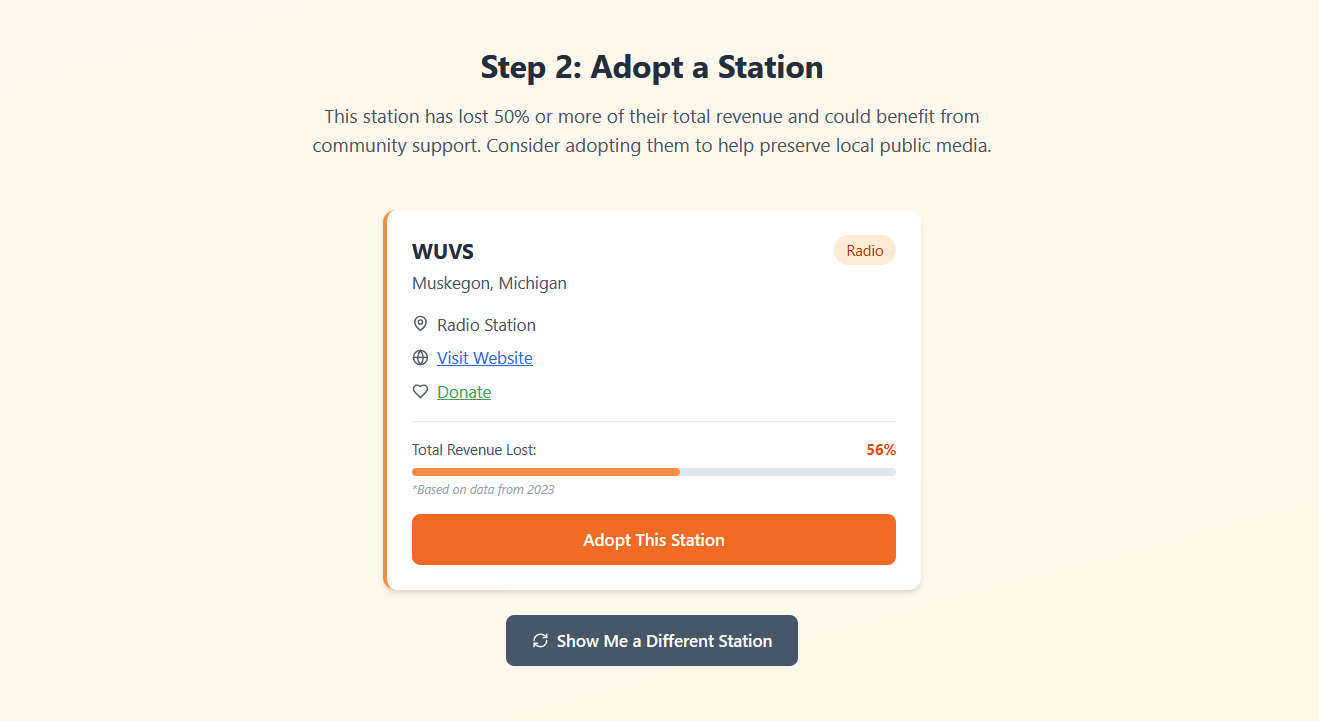
Two Updates to Adopt A Station
A large part of Adopt A Station’s success, in my mind, is its simplicity. Therefore, I’ve been careful about adding any unnecessary complexity to its design. But one of the unwritten rules about fundraising is that, for a potential donor, there should be as few barriers to giving as possible.
So, when some very generous friends offered to help collect and add the donation portals of each public media station on Adopt A Station, I couldn’t say no. Visitors being able to go to a station’s main site and explore the many unique ways that broadcaster serves their community is also a key part of the site’s success, so I opted to place the link to the station’s donation portal unobtrusively underneath the link to the main site.
Also, now the “Adopt This Station” button in the “adopt” section will send visitors to the station’s donation portal. If the station doesn’t have one, the button will revert to sending the visitor to the station’s main site instead.
The second major change to Adopt A Station is the ability to link directly to the listings of all U.S. states and territories (and Washington D.C.). I’ve been thinking about this change since I launched - remembering the unspoken rule about obstacles to giving - and the final nudge came from a station request for this very functionality.
I am exploring ways to increase Adopt A Station’s reach (send me a message if you have any ideas or would like to collaborate) and I think this new hyperlink scheme will at least help stations promote themselves while also pointing to the site.
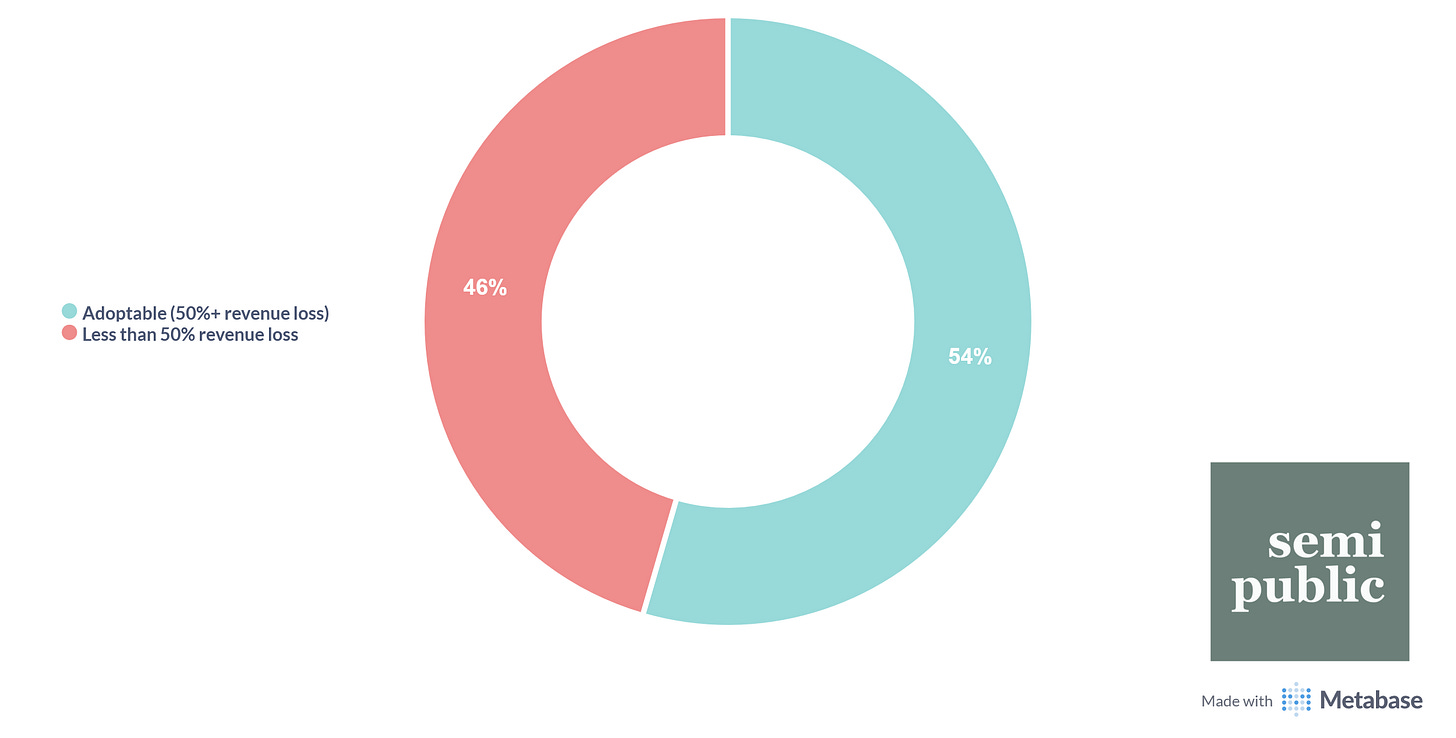
Is Adopt A Station Actually Working?
More than 20,000 people have visited the site since it launched on the morning of Sunday, July 20th. Of those visitors, 39% clicked on the website of any public media station - which I’ll refer to as outbound clicks. Just a few days earlier, that number was nearly 50%.
When looking at just the outbound clicks, stations that were listed in the “adoptable section” received 54% of those clicks. That means that 20% of all visitors to Adopt A Station as of August 1st visited the website of a station that stands to lose more than half of their total revenue.
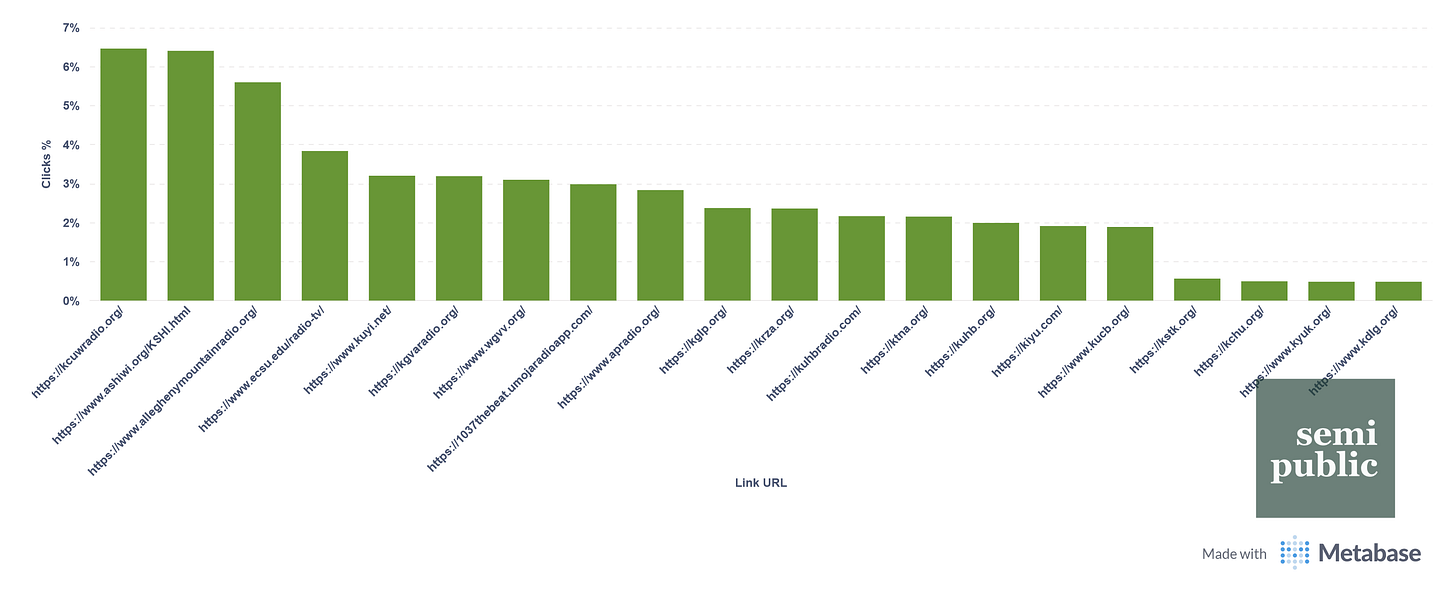
Overall, the distribution of outbound traffic among just “adoptable” stations seems to be inversely related to total percentage of revenue lost: My FY23 data shows that KCUW, the station with the most traffic, stands to lose about 99% of their total revenue, while KUCB stands to lose a smaller, but still extraordinarily devastating, 54% of their total revenue.
One of the primary goals of Adopt A Station when I built it was to encourage visitors to first consider donating to their local station before “adopting” another. I wasn’t sure how much traffic would actually go to station sites not in the “adopt” section, but I was surprised to find that it was nearly half, 46%.
That’s extraordinary: Not only are public media fans (and the people in their orbit) motivated enough to visit the websites of at-risk stations, they’re also motivated enough to visit their own station’s website. Sending visitors to the websites of stations they don’t know anything about is actually creating a halo effect for every other public media station.
The Real-World Impact and Final Thoughts
I’ve been asked several times how much money Adopt A Station has actually raised since its launch. Unfortunately (fortunately), there is no money that passes hands through the site, it is merely a webpage that directs visitors to other webpages, which means that my best metric is outbound clicks.
That being said, I’ve been cold-calling several stations listed in the “adoptable” section asking if they could tell me how much money they’ve raised from the website. Most of them have seen a significant uptick in out-of-state donations since the launch of Adopt A Station, but can’t necessarily attribute any of them to the site.
One station, however, was able to tell me definitively: Since the morning of July 20th, they've received over 50 donations from visitors arriving from Adopt A Station, totaling over $3,000. This station has had around 200 outbound clicks from my site, which means that one out of every four visitors coming from Adopt A Station donated. That’s the kind of conversion rate that non-profits work for years to achieve.
Overall, it’s clear that Adopt A Station is working. I cannot express how excited I am that at-risk stations are not only seeing traffic to their sites, but also actual donations.
If I had one negative thing to say, it would be that the traffic numbers suggest the campaign hasn’t reached outside of the public media bubble yet. I’m currently working on it, but if you have any ideas or know an organization that would like to partner with Adopt A Station to extend its reach, let me know. Let’s take this to the stratosphere.
If you enjoyed this post, please leave a like. It helps me understand what content is connecting with readers. Also, please consider supporting me with a paid subscription to Semipublic, or by buying me a coffee.



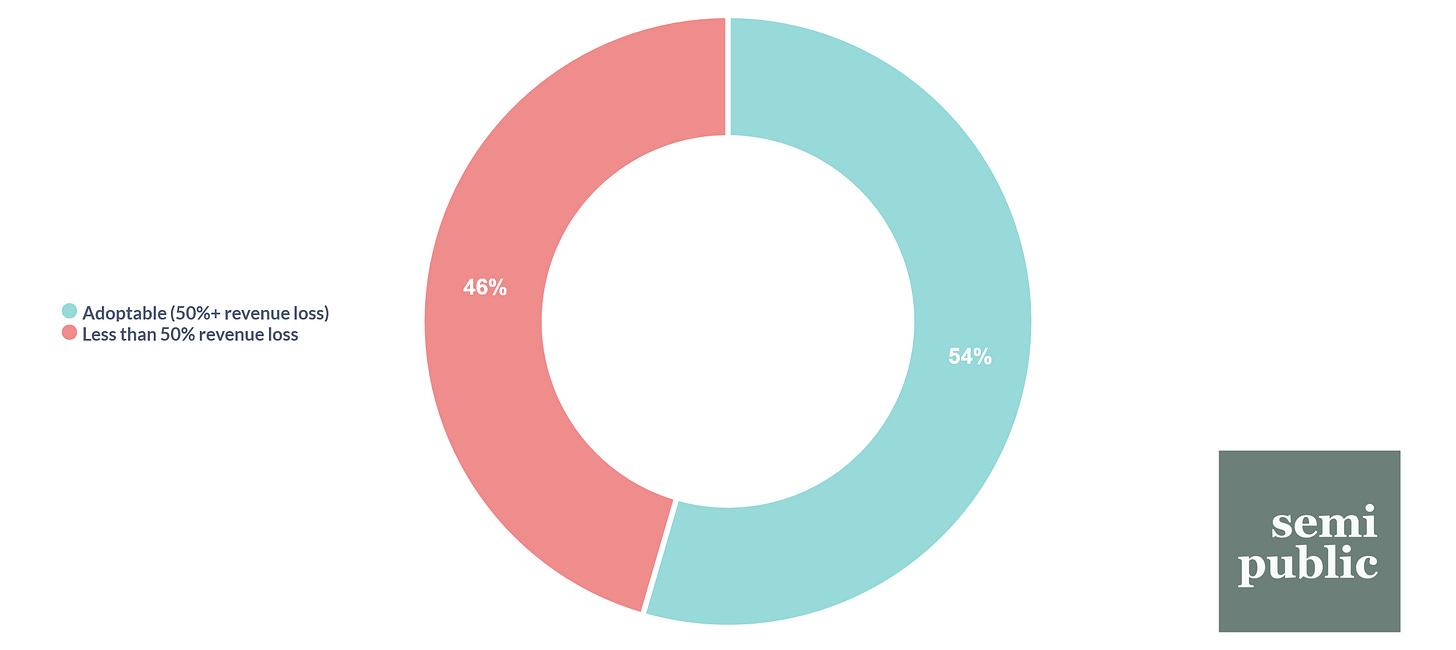
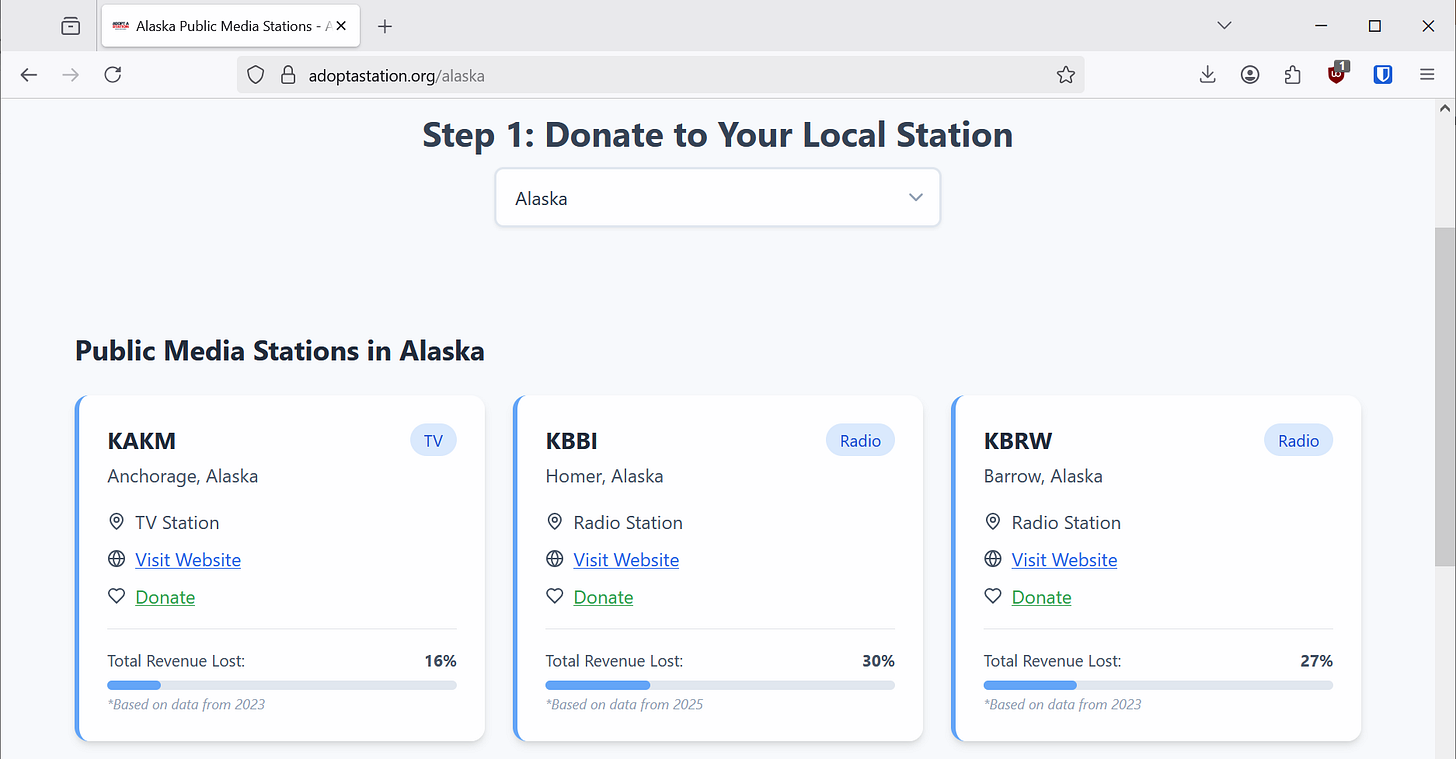
"... if you have any ideas or know an organization that would like to partner with Adopt A Station to extend its reach, let me know."
Alex, everyone who cares about democracy understands the importance of NPR and PBS. You should, IMHO, try partnering with national organizations like Indivisible. I'm quite sure more than a few of those contributions came from Northern Virginia Indivisible activists - we're spreading the word locally.
Hey Alex -- incredible, essential work. Thank you (and for your candor and transparency). Give me a shout at Quinn@importantnotimportant.com -- I think we can figure out some awesome ways to organically boost your reach through https://www.whatcanido.earth.